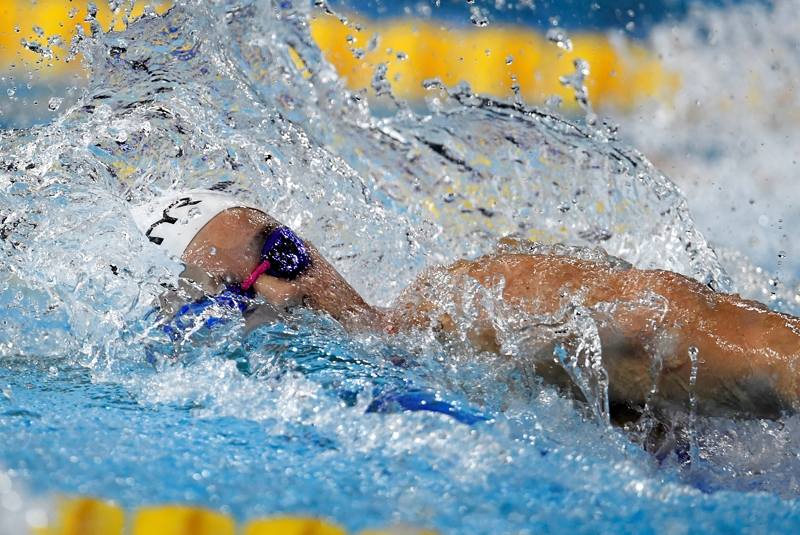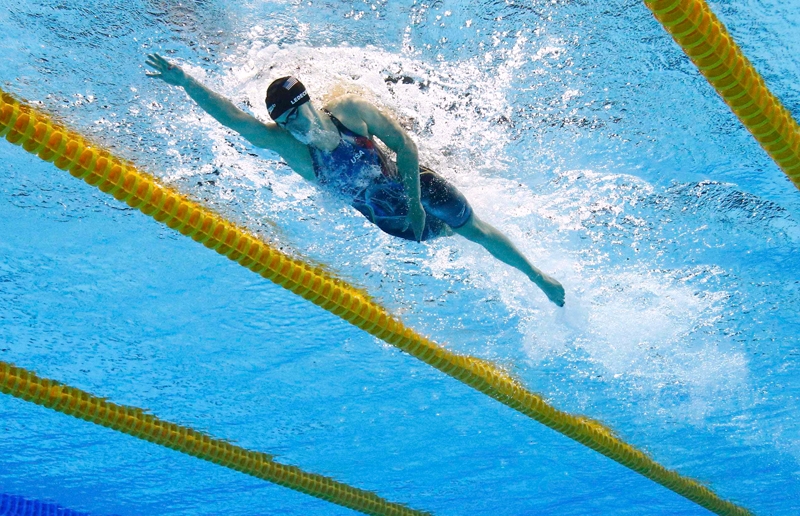Strength for swimming: could less actually be more?

SPB looks at new research on the optimum strength training load for swimming performance. Is more always better?
As regular readers will be aware, a huge body of data has accumulated over the year demonstrating that regular strength training brings multiple benefits for sportsmen and women. These include improved power, sprinting, acceleration, and change of direction ability, better endurance performance through higher levels of muscle economy (see this article), and greater resilience to injury. These strength-training benefits also extend to the water, where numerous studies have found that well developed levels of muscle strength and power play an important role in elite swimming performance(1-3).Dry land training benefits
In addition to ‘in the pool’ protocols designed to develop swimming strength (for example using hand paddles, swim parachutes etc – see this article and this article), dry-land training in the gym is also very popular and widely incorporated by coaches and swimmers into swimming programs at regional, national, and competitive levels(4,5). And while many coaches argue there’s a need for ‘specificity of training’ when performing dry-land training (ie using movements that approximate to the kinds of movement patterns a swimmer requires in his/her event), various recent studies have clearly demonstrated that dry-land training brings significant benefits in terms of metabolic adaptation, injury prevention and strength development to swimmers(6,7).For example, a study published last year indicated that the maximum strength of the upper and lower body is an excellent predictor of performance in sprint swimming(8). Meanwhile, the bench press has been highlighted by elite strength and conditioning coaches as an important exercise that can improve upper body strength and ultimately swimming performance(2). This is perhaps not surprising as the primary muscles activated in bench press (the pectoralis major of the chest, the triceps brachii of the upper arm and the deltoids of the shoulder) are also activated by front crawl swimming(9,10). The lower body muscles also play a crucial role in swimming performance, as several studies [11,12,20] have described the importance of lower body strength and power on swimming performance, including starting and turning performance(11,12).
How much, how hard?
When prescribing any strength program, the inevitable question arises of what training load should be used – ie how much should be performed and at what intensity? Training loads can be measured either using external or internal measures:- External training loads are objective measures of the work performed by the athlete (eg speed, acceleration, volume, training time, covered distance, or lifted weight).
- Internal training load is defined as the relative physiological and psychological stressors imposed on the athlete – eg perceived fatigue, blood lactate levels induced, post-exercise muscle damage etc.
What is the ideal amount of dry-land strength loading for swimmers seeking the largest performance gains in the water? Surprisingly, this is an area where there’s little agreement. The consensus view is that so long as overtraining does not occur, high training volume-loads will induce larger improvements on measures of swimming performance and muscular strength than moderate and low training volume-loads in swimmers. To date, this assertion has not been thoroughly tested in swimmers, but now a very recently published study by an international team of scientists has put this theory to the test(14).

New research
In this study, which was published in the International Journal of Environmental Research and Public Health, researchers set out to examine the effects of a 9-week maximal strength training on swimming performance. Thirty three swimmers competing at national level were recruited to the study, all of whom had at least four years of strength training experience. The strength training undertaken took place three times per week during the in-season period and consisted of just two exercises: bench press and leg press – deliberately chosen to highlight the transfer of these exercises and remove any other exercise bias. However, the strength protocol varied in terms of the total loading:- Low loading – 4 sets of 3-4 reps at 85-95% one-rep max (1RM)
- Medium loading – 4-5 sets of 3-5 reps at 85-95% 1RM (gradually increasing through the protocol)
- High loading 5-6 sets of 3-5 reps at 85-95% 1RM (gradually increasing through the protocol)
- Low - total kilos = 21342; RPE = 4.95
- Medium - total kilos = 27490; RPE = 6.82
- High - total kilos = 34154; RPE = 8.64
Impact on swimming performance
Before and after the strength intervention, all the swimmers performed two front crawl swimming tests in a 25m pool: a 25-metre front crawl test followed by a 50-metre font crawl test during which the start and turn performances were measured (the recovery between tests was set at 5-minutes). When the researchers looked at the test results, they observed that all the groups (low, medium and high loading) made significant improvements to 25-metre times, 50-metre times and the start/turn performance (see table 1).Table 1: Before and after 25 and 50-metre swim times by loading

And while there was a slight trend towards slightly greater improvements in the higher loading groups, these differences were too small to be considered significant. In plain English, the low loaded swimmers experienced the same magnitude of gains as the medium and high loaded swimmers – a result that surprised the researchers. These results were especially surprising given that the higher the loading protocol, the greater the strength gains achieved by the swimmers. For example, for the high, medium and low-loading protocols, the gains in 1RM for the bench press were 6.37kg, 4.46kg and 3.82kg respectively. Therefore, according to the previous research indicating that absolute strength predicts sprint swimming performance(8), we might have expected the high-loaded swimmers to have outperformed those performing lower loading – but this was not the case!
Practical implications
Why did the high and medium loading protocols fail to produce additional swimming performance benefits over and above the low-loading protocol? There are a number of explanations. One is that a protocol consisting only of bench press and leg press exercises was not ideally suited to producing gains in swimming performance. Another is that the exercises were not controlled for velocity in order to simulate the movement patterns in front crawl as closely as possible. Yet another possibility is that the medium and higher-loading protocols increased internal loading to the point where the swimmers’ recovery was harder, which impeded their ability to train as effectively as normal in the water.Regardless of the reason, these findings suggest that when strength training is added to a swimming program, a low-loading protocol (along the lines shown above) can be effective and should serve as the de facto starting point for swimmers. Higher loadings may not produce additional performance, and have the disadvantage of increasing the risk of injury and overtraining. For coaches, they also suggest that the introduction of a strength program should be accompanied with swim performance monitoring to see exactly what benefits are being gained for the time and effort invested. Another implication is that higher-loading strength work is best undertaken during the off season when interference with swim training is not an issue, and then downgraded to low-loading when the season begins.
References
- J Strength Cond Res. 2012 Feb; 26(2):497-505
- J Strength Cond Res. 2018 Sep; 32(9):2592-2600
- J Sports Sci Med. 2019 Dec; 18(4):805-811
- J Strength Cond Res. 2007 May; 21(2):599-605
- J Sports Sci Med. 2009; 8(3):357-65
- J Hum Kinet. 2020 Jan; 71():11-20
- J Exerc Sci Fit. 2021 Jan; 19(1):25-31
- J Strength Cond Res. 2021 Oct 1; 35(10):2839-2845
- J Exerc Sci Fit. 2021 Jan; 19(1):32-39
- J Hum Kinet. 2020 Jul; 73():7-18
- Br J Sports Med. 1992 Sep; 26(3):151-5
- Sports Med. 2019 Dec; 49(12):1957-1973
- Med Sci Sports Exerc. 2013 Jan; 45(1):186-205
- Int J Environ Res Public Health. 2021 Nov; 18(22): 11770
You need to be logged in to continue reading.
Please register for limited access or take a 30-day risk-free trial of Sports Performance Bulletin to experience the full benefits of a subscription. TAKE A RISK-FREE TRIAL
TAKE A RISK-FREE TRIAL
Newsletter Sign Up
Testimonials
Dr. Alexandra Fandetti-Robin, Back & Body Chiropractic
Elspeth Cowell MSCh DpodM SRCh HCPC reg
William Hunter, Nuffield Health
Newsletter Sign Up
Coaches Testimonials
Dr. Alexandra Fandetti-Robin, Back & Body Chiropractic
Elspeth Cowell MSCh DpodM SRCh HCPC reg
William Hunter, Nuffield Health
Keep up with latest sports science research and apply it to maximize performance
Today you have the chance to join a group of athletes, and sports coaches/trainers who all have something special in common...
They use the latest research to improve performance for themselves and their clients - both athletes and sports teams - with help from global specialists in the fields of sports science, sports medicine and sports psychology.
They do this by reading Sports Performance Bulletin, an easy-to-digest but serious-minded journal dedicated to high performance sports. SPB offers a wealth of information and insight into the latest research, in an easily-accessible and understood format, along with a wealth of practical recommendations.
*includes 3 coaching manuals
Get Inspired
All the latest techniques and approaches
Sports Performance Bulletin helps dedicated endurance athletes improve their performance. Sense-checking the latest sports science research, and sourcing evidence and case studies to support findings, Sports Performance Bulletin turns proven insights into easily digestible practical advice. Supporting athletes, coaches and professionals who wish to ensure their guidance and programmes are kept right up to date and based on credible science.









